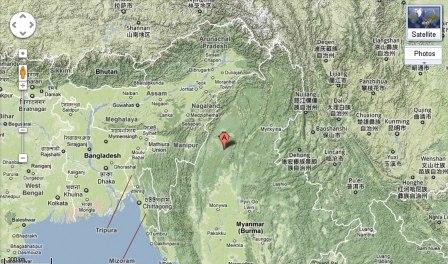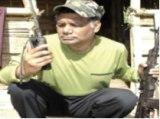ENDGAME FOR PARESH BARUAH
By Nava Thakuria
 Now it is almost official. Bad days are imminent for Paresh Baruah, the military chief of the banned United Liberation Front of Asom (ULFA). While the C-in-C of ULFA is losing ground in Bangladesh slowly, he on the other hand faces attacks from government forces in Burma (Myanmar).The illusive leader, who was hiding in Dhaka for many years, had recently left the country to hide somewhere in the Burma-China border areas. With the increasing strategic
relationship between Dhaka and New Delhi, Paresh finds it difficult to maintain his activities in Bangladesh, where he once led his armed outfit with the help of other ULFA political-wing leaders.
Now it is almost official. Bad days are imminent for Paresh Baruah, the military chief of the banned United Liberation Front of Asom (ULFA). While the C-in-C of ULFA is losing ground in Bangladesh slowly, he on the other hand faces attacks from government forces in Burma (Myanmar).The illusive leader, who was hiding in Dhaka for many years, had recently left the country to hide somewhere in the Burma-China border areas. With the increasing strategic
relationship between Dhaka and New Delhi, Paresh finds it difficult to maintain his activities in Bangladesh, where he once led his armed outfit with the help of other ULFA political-wing leaders.
The recent media reports have once again revealed that the ULFA in general and Paresh in particular had invested large sums of money in various Bangladeshi enterprises. The ULFA General Secretary Anup Chetia (now in a Bangladesh jail) took the initiative to invest money in some avenues in Bangladesh that would be beneficial for the outfit, which is fighting for a Swadhin Asom out of India. Anup even guided the outfit to invest in Bangladeshi politicians (who were pro-ULFA) and even a section of the media in Dhaka.
Now here is a secret list of investments initiated by Paresh in different Bangladeshi companies. Prepared by the Indian security and intelligence agencies with the help of Bangladesh National Security Intelligence, the report divulges that Paresh has investments in real estate, health sector, textiles, shipping, power projects and restaurants collectively worth $20 million, of course, with fake identities.
 The list, which was leaked to a section of the Indian media, discloses that the ULFA leader had invested around $14 million in three Dhaka-based real estate firms namely Basundhara Real Estate (17 % stake), Eastern Housing Project (9 %stake ) and Jamuna Group Housing Project (2 % stake). Paresh’s money is also in Chowdhury Shipping ($2.5 million), Kasem Textiles ($1.7 million), Samrita Hospital ($200,000), Chinese Restaurant Wimfray ($100,000) etc, the report also added that the hardliner ULFA leader receives nearly 5 lakh dollars annually through the Western Money Changer to spend in various activities.
The list, which was leaked to a section of the Indian media, discloses that the ULFA leader had invested around $14 million in three Dhaka-based real estate firms namely Basundhara Real Estate (17 % stake), Eastern Housing Project (9 %stake ) and Jamuna Group Housing Project (2 % stake). Paresh’s money is also in Chowdhury Shipping ($2.5 million), Kasem Textiles ($1.7 million), Samrita Hospital ($200,000), Chinese Restaurant Wimfray ($100,000) etc, the report also added that the hardliner ULFA leader receives nearly 5 lakh dollars annually through the Western Money Changer to spend in various activities.
Earlier, news was pouring in from Burma that the separatist militant outfits from the North East faced more attacks from the Burmese army. As the Burmese President Thein Sein is visiting India next month, the attacks on the hideouts of ULFA and other outfits in the jungles of northern Burma are expected to intensify. A recent statement from the ULFA camp revealed that its hideouts inside Burma were attacked by the government forces, but it claimed that all of its cadre escaped unhurt. Later another statement from ULFA claimed that Paresh had not received any bullet injuries in the offensive, as was widely reported in the media.
 With the ULFA, SS Khaplang (a Burmese) led National Socialist Council of Nagaland, Manipur People’s Liberation Army, UNLF and Prepak have training camps in the Sagaing division of Burma, where nearly 300 cadre are receiving intensive arms and ammunition training. To prove the claims, ULFA’s statement added a photograph of Paresh, which was the second photograph of the notorious leader released by the militant outfit in the last few months. The e-mail statement, issued by Paresh’s close associate Arunoday Dahotiya alleged that New Delhi had paid a huge amount of arms and money to the Burmese regime to go on the offensive against the militants. It is mentionable here that the Indian government had recently supplied 52 military truck loads of arms and ammunition to the Burmese government. India maintained its strategic and military relationship with the Burmese regime even after receiving brickbats from the international community. Expressing resentment at New Delhi’s continued military relationship with Nay Pie Taw, hundreds of pro-democracy Burmese and Indian activists demonstrated in New Delhi on July 22, 2011 arguing that ‘supplying arms to the most brutal military dictatorship may have grave consequences to millions of innocent lives’.
With the ULFA, SS Khaplang (a Burmese) led National Socialist Council of Nagaland, Manipur People’s Liberation Army, UNLF and Prepak have training camps in the Sagaing division of Burma, where nearly 300 cadre are receiving intensive arms and ammunition training. To prove the claims, ULFA’s statement added a photograph of Paresh, which was the second photograph of the notorious leader released by the militant outfit in the last few months. The e-mail statement, issued by Paresh’s close associate Arunoday Dahotiya alleged that New Delhi had paid a huge amount of arms and money to the Burmese regime to go on the offensive against the militants. It is mentionable here that the Indian government had recently supplied 52 military truck loads of arms and ammunition to the Burmese government. India maintained its strategic and military relationship with the Burmese regime even after receiving brickbats from the international community. Expressing resentment at New Delhi’s continued military relationship with Nay Pie Taw, hundreds of pro-democracy Burmese and Indian activists demonstrated in New Delhi on July 22, 2011 arguing that ‘supplying arms to the most brutal military dictatorship may have grave consequences to millions of innocent lives’.
ULFA, which was born in 1979 to make Assam independent of India, today is a divided house, as its Chairman Arabinda Rajkhowa with his followers have joined in the peace process with New Delhi. However, ULFA’s Commander-in-Chief continues sticking to the primary demand for an independent Assam.
Dahotiya’s e-mail claimed that New Delhi paid a special economic package worth `20,000 crores to flush out the rebel camps from Burmese soil. Additionally, the Burmese government is offered (by Indian government) `100 crore to kill Paresh at the earliest, added the statement. It additionally said that New Delhi has been maintaining the practice (to pay neighboring countries in need) for a long time and paid a `1000 crore package to Bhutan to destroy ULFA, following which Thimphu flushed out the ULFA camps inside south Bhutan in December 2003. Dahotiya also claimed that New Delhi had recently offered money to the Dhaka government led by Awami League chief Sheikh Hasina with a request to take action against ULFA leaders and cadre taking shelter in that country. Accordingly, Dhaka handed over many militant leaders (including the ULFA Chairman) to Indian authorities. Though India and Bangladesh do not have an extradition treaty, the Bangladesh authorities arrested the militant leaders and secretly handed them over to India. No official statement was issued by the Bangladesh government on the matter and even the Bangladeshi newspapers had to depend on India’s media to report about the important issue.


